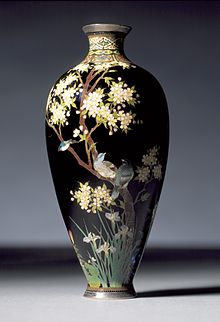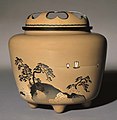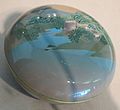Namikawa Yasuyuki

Namikawa Yasuyuki (1845–1927) — original family name Takaoka[1] — was a Japanese cloisonné artist. His work was highly sought after in his own lifetime and is held in several collections today.[2] He and Namikawa Sōsuke (no relation)[notes 1] were the most famous cloisonné artists of the 1890 to 1910 period, known as the "Golden age" of Japanese enamels.[3] From 1875 to 1915, he won prizes at 51 exhibitions, including at world's fairs and at Japan's National Industrial Exhibition.[4] For his work he was appointed an Imperial Household Artist in 1896.[3] He sometimes signed his pieces Kyoto Namikawa (Namikawa of Kyoto).[5]
Biography
[edit]A former samurai, Namikawa Yasuyuki started work as an artist around 1868, working for the Kyoto Cloisonné Company from 1871 to 1874 and eventually forming his own company.[6] He gave tours of his workshop; one visitor was the English writer Rudyard Kipling.[7][8] These tours began in a garden to introduce Japanese aesthetics, and Namikawa would show the many stages of his production process, including fourteen polishing stones of different roughness that were used in sequence.[7]
Along with Namikawa Sōsuke, he was one of only two cloisonné artists ever to be appointed Imperial Household Artist.[9] These artists were given a yearly stipend and were commissioned by the Imperial family to make presentation wares as gifts for foreign dignitaries.[10] After the Meiji era, foreign demand for Japanese art tailed off.[8] Namikawa Yasuyuki retired in 1919[6] and his workshop closed in 1923.[8]
Style
[edit]
The collector Donald Gerber distinguishes three schools of Japanese cloisonné and places Namikawa at the head of the Kyoto, or naturalistic, school.[2]
He invented the first transparent black glaze, which led to the development of other transparent enamels.[11] He used intricate wire work and is known for attention to detail.[3] His early work used geometrical motifs or stylised representations of plants. His style became more pictorial over his career, usually depicting Kyoto's landmarks.[3] He also worked with larger and more varied vases.[7] Colourful figures on a yellow ground are one of his identifying marks.[5] His style was shaped by his contact with Gottfried Wagener, a German scientist brought to Japan by the government to help modernise Japanese industry.[5] Together they developed a semi-transparent mirror black enamel that became a hallmark of Namikawa's work.[6] By 1893 Namikawa had learned to hide background wires, creating solid areas of enamel.[2]
Judges at Japan's fourth National Industrial Exhibition in 1895 remarked on Namikawa's change of stylistic approach when awarding him first prize:
"[H]ere flowers of the four seasons, with birds of exquisite coloring, are set on to a black background color, forming a picture far beyond a mere pattern. But he seems still to adhere to the traditional methods of depiction, not attempting to imitate brushwork as do some other persons. He places great emphasis on fine wirework and on a flawless surface with no pitting or bubbles, achieved through painstaking study of glazing and firing."[12]
At the National Industrial Exhibition of 1881, Namikawa was awarded second prize for a copper vase "of elegant shape with opaque and transparent colors and complicated wire-work, with no trace of cracks."[5]
Collections
[edit]Many of his works are in collections today such as the Ashmolean Museum,[13] the Victoria and Albert Museum,[14] the Los Angeles County Museum of Art[15] and Khalili Collection of Japanese Art. The Namikawa Cloisonne Museum of Kyoto (ja) and Kiyomizu Sannenzaka Museum (ja) in Higashiyama-ku, Kyoto, exhibits a range of his items.
The most highly acclaimed and famous of his works is the 1899 Vase with Flowers and Birds of the Four Seasons (四季花鳥図花瓶) which is owned by the Museum of the Imperial Collections.[16][17] This work was exhibited at the Exposition Universelle held in Paris in 1900 and received the gold prize.[4][18]
Gallery
[edit]- Koro, 19th century
- Jar with cover
- Box with butterfly design, 1890
- Chrysanthemum and ivy bottle, 1892
- Koro and cover, circa 1910
- Incense container with landscape design, 1910
- Vase with houses in a landscape, 1910-1915
See also
[edit]Notes
[edit]- ^ Despite their identical pronunciation, Namikawa Yasuyuki and Namikawa Sōsuke's family names are written differently in Chinese characters.(Earle 1999, p. 254)
References
[edit]- ^ Japanese Biographical Index. Walter de Gruyter. 6 February 2013. ISBN 978-3-11-094798-4.
- ^ a b c Seton, Alistair (26 June 2012). Collecting Japanese Antiques. Tuttle Publishing. p. 388. ISBN 978-1-4629-0588-1.
- ^ a b c d Irvine, Gregory (2013). "Wakon Yosai- Japanese spirit, Western techniques: Meiji period arts for the West". In Irvine, Gregory (ed.). Japonisme and the rise of the modern art movement : the arts of the Meiji period : the Khalili collection. New York: Thames & Hudson. p. 177. ISBN 978-0-500-23913-1. OCLC 853452453.
- ^ a b Toyoro Hida, Gregory Irvine, Kana Ooki, Tomoko Hana and Yukari Muro. Namikawa Yasuyuki and Japanese Cloisonné The Allure of Meiji Cloisonné: The Aesthetic of Translucent Black, pp.182-188, The Mainichi Newspapers Co, Ltd, 2017
- ^ a b c d Earle 1999, pp. 51–52.
- ^ a b c "History of Cloisonné in Japan". Victoria and Albert Museum. 20 July 2011. Retrieved 20 July 2020.
- ^ a b c "Polished to Perfection". Asian Art Newspaper. 5 November 2017. Retrieved 20 July 2020.
- ^ a b c Yamada, Mio (7 February 2017). "Yasuyuki Namikawa: A master of cloisonne color and design". The Japan Times. Retrieved 20 July 2020.
- ^ Baekeland, Frederick (1980). Imperial Japan: The Art of the Meiji Era, 1868-1912 : an Exhibition. Herbert F. Johnson Museum of Art, Cornell University. pp. 184–185.
- ^ Earle 1999, pp. 348–349.
- ^ Leonard, Loryn (26 June 2012). "How It's Made: Japanese Cloisonné". Dallas Museum of Art Uncrated. Retrieved 6 May 2020.
- ^ Earle 1999, p. 232.
- ^ "Eastern Art Online, Yousef Jameel Centre for Islamic and Asian Art". jameelcentre.ashmolean.org. Ashmolean Museum, University of Oxford. Retrieved 15 May 2020.
- ^ "Search the Collections | Victoria and Albert Museum". collections.vam.ac.uk. Retrieved 15 May 2020.
- ^ "Namikawa Yasuyuki | LACMA Collections". collections.lacma.org. Retrieved 15 May 2020.
- ^ Toyoro Hida, Gregory Irvine, Kana Ooki, Tomoko Hana and Yukari Muro. Namikawa Yasuyuki and Japanese Cloisonné The Allure of Meiji Cloisonné: The Aesthetic of Translucent Black, p.127, The Mainichi Newspapers Co, Ltd, 2017
- ^ 四季花鳥図花瓶(しきかちょうずかびん) Imperial Household Agency
- ^ 海外博覧会の受賞歴と旧邸宅の構造から見る並河靖之の国際的な評価 Ginza Shinseidō
Sources
[edit]- Earle, Joe (1999). Splendors of Meiji : treasures of imperial Japan : masterpieces from the Khalili Collection. St. Petersburg, Fla.: Broughton International Inc. ISBN 1874780137. OCLC 42476594.
Further reading
[edit]- Schneider, Frederic T. (2010). The Art of Japanese Cloisonné Enamel: History, Techniques and Artists, 1600 to the Present. Jefferson NC: McFarland. pp. 86–87. ISBN 9781476662763. OCLC 934637505.
External links
[edit]![]() Media related to Namikawa Yasuyuki at Wikimedia Commons
Media related to Namikawa Yasuyuki at Wikimedia Commons


 French
French Deutsch
Deutsch





